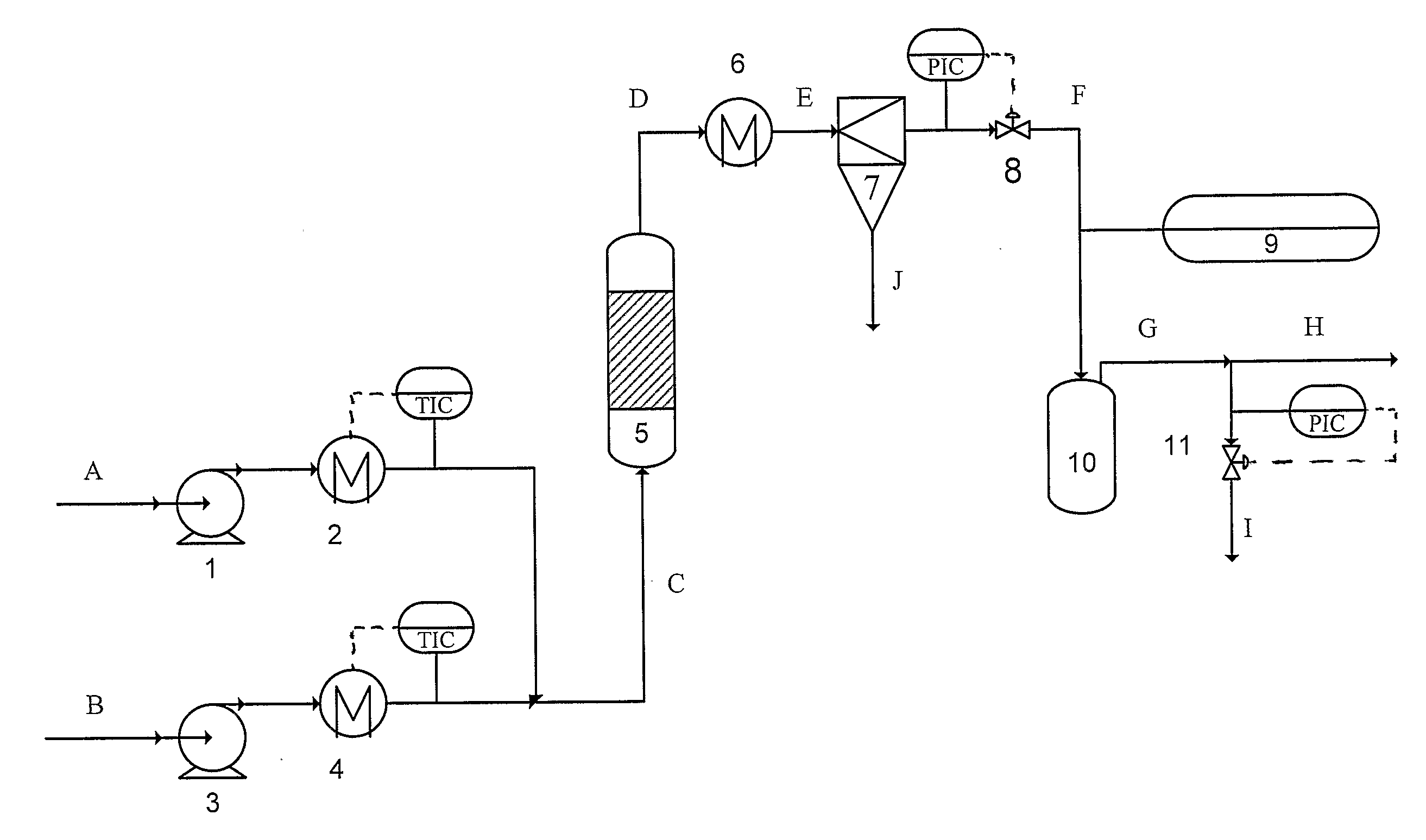Method and apparatus for converting organic material
a technology of organic material and conversion method, applied in the direction of hydrocarbon from oxygen organic compound, liquid gas reaction process, energy-based wastewater treatment, etc., can solve the problems of high energy price, negative overall process energy, and increased energy inpu
- Summary
- Abstract
- Description
- Claims
- Application Information
AI Technical Summary
Benefits of technology
Problems solved by technology
Method used
Image
Examples
example 1
Illustrative Example 1
[0184]Anaerobic digested sewage sludge below was converted according to the method of the present invention in the laboratory scale plant shown in FIG. 1.
[0185]The dry matter content of the sewage sludge was 5%. The main components of the dry matter in weight % were:
[0186]C=28.30%
[0187]H=4.33%
[0188]N=3.55%
[0189]O=28.40%
[0190]P=4.49%
[0191]Al=7.77%
[0192]Si=7.44%
[0193]Ca=6.95%
[0194]Fe=3.17%
[0195]K=1.62%
[0196]An elemental analysis of sewage sludge dry matter was further analyzed by induced coupled plasma (ICP) revealing the following composition:
C [%]O [%]Al [%]H [%]Ca [%]Si [%]N [%]P [%]K [%]30.930.56.155.25.034.984.664.622.36MnCl [%]S [%]Fe [%]Na [%]Mg [%]Zn [%]Ti [%]Ba [%][%]1.131.091.040.9380.8750.2260.1950.06520.0375
[0197]The combustible fraction amounts to 58% of the dry matter content, with a heat value of 22.2 MJ / kg, which translates into a calorific value of 476 KJ / kg in the sewage sludge as received.
[0198]Prior to the test the s...
example 2
Illustrative Example 2
[0215]Anaerobic digested sewage sludge with characteristics as given above in example was preheated and converted using the same catalyst and experimental set-up.
[0216]140 g / h of the pretreated sewage sludge was pressurized to 250 bar and heated to 230 C in the pre-heating step. This stream was mixed with 414 g / h of pressurized water heated to a temperature so as to obtain a substantially constant temperature of 300±5 C after mixing.
[0217]The mixed flow was subsequently contacted with the heterogeneous catalyst in the reactor. The feed to water ratio translates into a water to feed ratio of 3:1, and the total flow of 545 g / h translates into a contact time of 3.3 minutes.
[0218]After to the contact with the heterogeneous catalyst, the fluid containing the converted organic material is cooled to ambient temperature, filtered through a particle filter for collection of suspended particles, and expanded to ambient pressure. The liquid frac...
example 3
Illustrative Example 3
Conversion of Corn Silage
[0228]Corn silage was pretreated and converted using the same catalyst and experimental set-up as described above in example 1 and 2.
[0229]Prior to the test the sewage sludge was pretreated by sizing to less than 1 mm by cutting longer particles by a Seepex macerator (type 25 / 15-I-I-F12-2) and milling by a colloid mill (Probst und Class, type N100 / E), and filtered by a screen basket filter (mesh width 1 mm).
[0230]Subsequently 1.5% by weight of potassium in the form of potassium carbonate was added to the resulting slurry. The pH value of the slurry was 9.6.
[0231]The characteristics of the corn silage after the pretreatment was the following:
Corn silage feedstockDry matter content [% weight]11.29Inorganic fraction of dry matter [%29.4Weight]Density [kg / m3]1.0099pH9.6Heat of combustion1 [kJ / kg]14351Based on 18 MJ / kg heat of combustion for the organic fraction of the dry matter.
[0232]The inorganic content of the dry matter was mainly the a...
PUM
| Property | Measurement | Unit |
|---|---|---|
| pressure | aaaaa | aaaaa |
| pressure | aaaaa | aaaaa |
| pressure | aaaaa | aaaaa |
Abstract
Description
Claims
Application Information
 Login to View More
Login to View More - R&D
- Intellectual Property
- Life Sciences
- Materials
- Tech Scout
- Unparalleled Data Quality
- Higher Quality Content
- 60% Fewer Hallucinations
Browse by: Latest US Patents, China's latest patents, Technical Efficacy Thesaurus, Application Domain, Technology Topic, Popular Technical Reports.
© 2025 PatSnap. All rights reserved.Legal|Privacy policy|Modern Slavery Act Transparency Statement|Sitemap|About US| Contact US: help@patsnap.com



